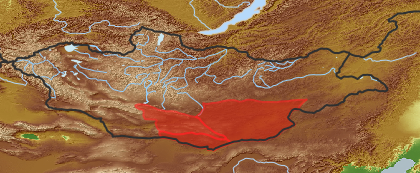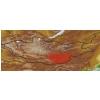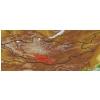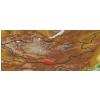| Class: | angiosperms |
| Order: | Caryophyllales |
| Family: | Chenopodiaceae |
| Genus: | Salsola |
| Scientific name: | Salsola laricifolia Turcz. ex Litv. |
| Name acc. to: | Gubanov 1996 |
| Herbar: | list records   |
| Description: | lLike S. arbuscula but: bark rather grey. Leaves shorter, alternate, fascicular on dwarf branches,10-205×1 mm, slightly incurved, semiterete to subclavate, mucronate. Bracts leave-like but bracteoles shorter than perianth, with wide hyaline margins forming a collar-like structure around the flower. Fruits 8-11 mm in diameter, tepals above wings forming a cone. |
| Confuse with: | S. abrotanoides, S. arbuscula |
| Tax. Comments: | Eastern species closely allied to S.arbusculiformis Drob. with more western distribution. Resembles to S arbuscula. |
| Comments: | The morphological differences and delimitations between S. abrotanoides, S. arbusculiformis and S. laricifolia should be examined critically. |
| Link to Flora of China: | http://www.efloras.org/browse.aspx?flora_id=2&name_str=Salsola+laricifolia |
| open map in a new window |  |
| Habitat: | Debris and stony slopes of mountains, hills and upper parts of tailings (bels), rocks and outcrops of primary rocks, on granite outcrops, sayr slopes, badlands and screes sparsely and as edificator of black saltwort deserts (Grubov 2001). |
| Habit (i)general appearance of a plant | |
| Growth form: (i)Herb, shrub, tree or climber. | shrub, subshrub or semishrub (i)Shrub, multi-stemmed, mostly (0.2) 0.5 - 5 m high, shoots woody up to the tip
example: Caragana leucophloea 
|
| Parasite status: (i)Is the plant a half- or full parasite? | no parasite/saprophyte (i)Plant fully autonomous, leaves with chlorophyll
example: Most plants, Ranunculus  inherited by family Chenopodiaceae: no parasite/saprophyte inherited by family Chenopodiaceae: no parasite/saprophyte
|
| Water or terrestrial plant: (i)Where do the plants grow? | terrestrial (i)Plant grows on dry land
example: Orostachys spinosa  inherited by family Chenopodiaceae: terrestrial inherited by family Chenopodiaceae: terrestrial
|
| Leaf (i)expanded, usually photosynthetic organ of a plant (including phylloclades) | |
| Leaf development: (i)Structure and development of leaves. | with green leaves (i)Plant with green leaves  inherited by genus Salsola: with green leaves inherited by genus Salsola: with green leaves
without green leaves (i)Plant at flowering time (some geophytes) or over its whole life (many parasites) with reduced leaves without chlorophyll
example: Colchicum, Cuscuta, a lot of parasites  inherited by family Chenopodiaceae: without green leaves inherited by family Chenopodiaceae: without green leaves
|
| Leaf arrangement: (i)Arrangement of leaves at the stem. | opposite, opposite-decussate (i)Two leaves per node
example: Lamiaceae, e.g. Phlomis    inherited by family Chenopodiaceae: opposite, opposite-decussate inherited by family Chenopodiaceae: opposite, opposite-decussate
alternate (i)One leaf per node; distiche: arranged in two vertical rows, equitant
example: Phragmites    inherited by family Chenopodiaceae: alternate inherited by family Chenopodiaceae: alternate
|
| Simple or divided leaves: (i)Are the leaves simple or completely divided in several parts? Blade of the leaf entire or (more or less) deeply dissected. Attention: There are various appearances of the leaf margin (from entire to toothed and lobed). Here, we ignore this and ask only for dissections that separate the leaf for more than one third of its length or width, whatever is smaller. Sometimes, it is difficult to tell apart compound leaves from a shoot system with simple leaves: look for stipulae and/or axillary buds at the ground of the leaves: if only some possess these structures, the others are most likely leaflets of a compound leaf. | simple (i)Non-divided leaf, but margin may be incised nearly to the ground   inherited by family Chenopodiaceae: simple inherited by family Chenopodiaceae: simple
|
| Leaf margin: (i)Structure of leaf margin (or that of a leaflet in case of compound leaves). Attention: Here we ask for the leaf margin, defined as all those dissections that separate the leaf for less than one third of its length or width, whatever is smaller. To be worked out: how to handle margin of pinnate leaves? | entire (i)Plain margin, not toothed
example: Iris   inherited by genus Salsola: entire inherited by genus Salsola: entire
|
| Stipule: (i)Leaflets at the base of the petiole, these are smaller and of different shape. | none (i)Without stipules
example: Euphorbia, Ericaceae s.l.  inherited by family Chenopodiaceae: none inherited by family Chenopodiaceae: none
|
| Leaf veination: (i)Arrangement of the main veins of a leaf. | pinnate (i)One main vein, several side veins, sometimes inconspicuous
example: Cicerbita     inherited by family Chenopodiaceae: pinnate inherited by family Chenopodiaceae: pinnate
|
| Flower (i)reproductive portion of the plant, consisting of sepals, petals, stamens, and pistils | |
| Flower appearance and pollination: (i)General appearance of the flower. | not attractive, wind-pollinated or some water plants (i)Small, colourless or green flowers
example: Betula, grasslike plants: Carex, Setaria, Juncus  inherited by family Chenopodiaceae: not attractive, wind-pollinated or some water plants inherited by family Chenopodiaceae: not attractive, wind-pollinated or some water plants
|
| Flower colour: (i)Attention: assess colour of the most colourful parts of the flower, but not of the stamens; be aware of single plants with a mutation (mostly white) on flower colour. | colourless (i)Dry membranous  inherited by family Chenopodiaceae: colourless inherited by family Chenopodiaceae: colourless
greenish (i)petals absent or not distinctly different from colours of leaves, only stigmas (white) or anthers (yellow) may differ in color
example: Chenopodium, Triglochin  inherited by family Chenopodiaceae: greenish inherited by family Chenopodiaceae: greenish
pink (i)Between red and white
example: Centaurium  inherited by family Chenopodiaceae: pink inherited by family Chenopodiaceae: pink
|
| Perianth arrangement: (i)Attention: in some plants, flowers may be dimorphic in different ways (dioecious or gynodioecious). If flowers vary, record the characters of the most showy flowers. | simple, similar (i)Only one type of perianth leaves (tepals)
example: Tulipa   inherited by family Chenopodiaceae: simple, similar inherited by family Chenopodiaceae: simple, similar
|
| Diameter of flower: (i)Diameter of flower or flower head. | from 5 mm to 10 mm (i)
example: Stellaria  inherited by family Chenopodiaceae: inherited by family Chenopodiaceae:
|
| Flower symmetry: (i)Symmetry of the perianth leaves. Attention: to assess this character, look on sepals, petals and stamens, but neglect carpels and ovary. | radiary, regular (actinomorphic) (i)More than two axis of symmetry
example: Saxifraga: 5; Iris: 3   inherited by family Chenopodiaceae: radiary, regular (actinomorphic) inherited by family Chenopodiaceae: radiary, regular (actinomorphic)
|
| Flower form: (i)common forms of flowers ? Veronica | simple (flat) - Do not confuse with inflorescences as in some Asteraceae (i)Petals spread out, flower appearing flat
example: Mollugo, Trientalis, Pulsatilla, Saxifraga   inherited by family Chenopodiaceae: simple (flat) - Do not confuse with inflorescences as in some Asteraceae inherited by family Chenopodiaceae: simple (flat) - Do not confuse with inflorescences as in some Asteraceae
|
| Sepal number: (i)Number of sepal leaves (outer perianth leaves, calyx leaves, mostly greenish). Attention, this character applies only for flowers separated in sepals and petals, thus excluding most monocots. Be aware of the bracts (involucral leaves) of Asteraceae flowerheads, do not qualify these as sepals! Be also aware in Rosaceae is often an epicalyx developed, in this case count all parts. | 5 (i)
example: Polemonium  inherited by family Chenopodiaceae: 5 inherited by family Chenopodiaceae: 5
|
| Sepal fusion: (i)To which degree are the sepal leaves connected? Attention, this character applies only for flowers separated in sepals and petals, thus excluding most monocots. Be aware of the bracts (involucral leaves) of Asteraceae flowerheads, do not qualify these as sepals! | free (i)All leaves separate from each other
example: Geranium  inherited by family Chenopodiaceae: free inherited by family Chenopodiaceae: free
|
| Petal / Tepal number: (i)Number of petal leaves (inner perianth leaves, usually coloured). | 5 (i)
example: Potentilla  inherited by family Chenopodiaceae: 5 inherited by family Chenopodiaceae: 5
|
| Petal / Tepal fusion: (i)To which degree are the petal leaves connected? Petals sympetalous. | free (i)all petal leaves separate from each other
example: Anthriscus  inherited by family Chenopodiaceae: free inherited by family Chenopodiaceae: free
|
| Spur: (i)A hollow, slender, sac-like appendage of the perianth leaves, storing nectar. | no spur (i)Flower without appendage
example: Peganum  inherited by family Chenopodiaceae: no spur inherited by family Chenopodiaceae: no spur
|
| Stamen number: (i)Attention: We ask for the reproductive organs of the flower dispersing pollen. Count only fully fertile stamens, not staminodia (e.g. Parnassia). | 5 (i)
example: Peucedanum  inherited by family Chenopodiaceae: 5 inherited by family Chenopodiaceae: 5
|
| Stamen fusion: (i)To which degree are the stamens fused? Attention: Whereas the pollen sacs itself are often free., their stalks (filaments) may be fused. Here, we count them as fused if they are together over at least one thirth of their length. | free (i)Stamens with separate bases
example: Malus  inherited by family Chenopodiaceae: free inherited by family Chenopodiaceae: free
|
| Pistil number: (i)Number of pistils (female floral organs: style, if developed; stigma and carpels/ovary together build the pistil). | 2 (i)Two stigmas, often cleaved like a snakes tongue
example: Salvia, Arnica, Bupleurum, Bromus, Saxifraga, Veronica  inherited by family Chenopodiaceae: 2 inherited by family Chenopodiaceae: 2
3 (i)Three stigmas, usually in a triangle
example: Stellaria, Euphorbia, Campanula, Allium  inherited by family Chenopodiaceae: 3 inherited by family Chenopodiaceae: 3
5 (i)Five stigmas, usually in a whorl
example: Cerastium  inherited by family Chenopodiaceae: 5 inherited by family Chenopodiaceae: 5
|
| Carpel number: (i)Number of carpels (carpel: forming a simple pistil or part of a compound pistil, modified leaf). | 2  inherited by family Chenopodiaceae: 2 inherited by family Chenopodiaceae: 2
|
| Carpel fusion: (i)To which degree are the carpels (modified leaf forming simple pistil or part of a compound pistil) fused. | fused (i)Carpels united into an ovary, only styles are free
example: Malus, Berberis  inherited by family Chenopodiaceae: fused inherited by family Chenopodiaceae: fused
|
| Style number: (i)Portion of the pistil connecting the stigma to the ovary. | 1  inherited by family Chenopodiaceae: 1 inherited by family Chenopodiaceae: 1
|
| Ovary position: (i)For entirely or partly fused carpels, describe their position in relation to the insertion point of perianth leaves (best done by doing a longitudinal section of a flower). | superior (hypogynous) (i)Base of carpels attached above insertion point of perianth leaves, carpels free or fused
example: Delphinium, Anemone    inherited by family Chenopodiaceae: superior (hypogynous) inherited by family Chenopodiaceae: superior (hypogynous)
|
| Root / shoot below ground (i)plant part below ground (in most cases), including below ground shoots, without leaves | |
| Root type: (i)Organisation of the roots. | allorhizous (i)Plant with a conspicuous tap root, one larger tap root with side roots
example: Dicotyledonae  inherited by order Caryophyllales: allorhizous inherited by order Caryophyllales: allorhizous
|
| Distribution (i)region where the plant is likely to be found | |
| Distribution (Veg. Zones): (i)acc. to Grubov 1952 | East Gobi (i)In distribution data often named as '12' 
Gobi-Altai (i)In distribution data often named as '13' 
Alashan Gobi (i)In distribution data often named as '16' 
acc. to: Gubanov 1996 |
| Plant Use | |
| Medical Plant Use: (i)Only if plant is used as medical plant | Parts used: aboveground part, root (i)Parts of Plants used in medicine
Ingredients: coumarins (cleomiscosins) (i)Medically effective ingredients
Use: Extract of aerial parts of the plant have astringent, anti-inflammatory and purgative effects. Root extract of this plant extends lifespan, improve immunity and resistance against diseases. Mongolian scientists have developed medicines, called ‘Salorid’, ‘Salimon’ which are considered to improve immune system; The aboveground part is used in Mongolian folk medicine in form of tea-blend as a re-constituent for promoting the working ability and recovering of fatigue of feeble and old men. In experiment,the extract obtained from the root showed insignificant inhibition of exhaustion process, prolongation of life in cases of starvation (fasting), decrease of average daily loss of body weight in rabbit.The extract from the root of this plant insignificantly increases the speed of recovery of body weight of preliminarily famished animals in their fatting and provokes more marked average daily addition of body weight in g/kg. The extract of root possesses diuretic activity and did not show any side effect and toxicity. It raised body restibility and intensified immunogeneticity of organism. (i)Medical use in eastern and western medicine
acc. to: Makkar et al 2009; Ligaa et al 2009; Wang et al 2011 |
| General Use: | medical plant
|
| Plant Status | |
| Local Names: | local names: Budargana (acc. to Makkar 2009)
|